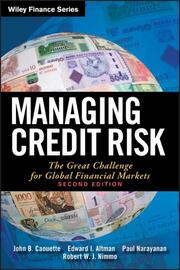Detailansicht
Managing Credit Risk
The Great Challenge for the Global Financial Markets - Wiley Finance, Wiley Finance Editions
Caouette, John B/Altman, Edward I/Narayanan, Paul et al
ISBN/EAN: 9780470118726
Umbreit-Nr.: 1862263
Sprache:
Englisch
Umfang: 656 S.
Format in cm: 4.6 x 23.5 x 16
Einband:
gebundenes Buch
Erschienen am 06.06.2008
Auflage: 2/2008
€ 91,90
(inklusive MwSt.)
Nachfragen
